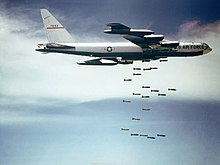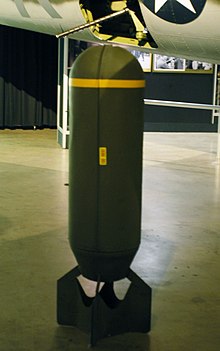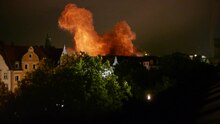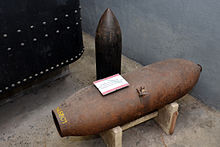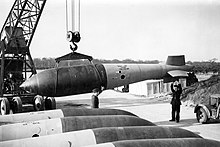Aerial bomb
An aerial bomb (also drop weapon or drop ammunition ) is a bomb that is dropped from an aircraft , a bomber , and, depending on the ignition system, explodes on impact, at a low height above the ground, after penetrating a target or after a delay. Unguided bombs, dropped from a great height, are a very imprecise weapon, which is why a larger area often has to be covered with bombs so that the actual target is hit. Bombs common today mostly steer themselves to the target, but are ethically controversial due to possible malfunction and the affected environment of the target. They are often seen as an uncivilized and reprehensible means of waging war. The bombing of areas ( area bombing ) was often used as a terrorist attack to spread fear and terror in the population, to kill or injure as many people as possible and to destroy the infrastructure.
Distinction
A distinction is made between aircraft bombs:
- according to their mode of action in the target, among other things:
- Explosive bombs in the broader sense are filled with explosives and explode “as a whole”. These include multi-purpose bombs, cluster bombs , anti-tank bombs and air mines .
- Cluster bombs are containers that contain a large number of submunitions ("small bombs"). A cluster bomb is supposed to cover a larger area evenly with "effect". Because of the large number of duds and the resulting frequent accidents, they are humanitarian and ethical controversial.
-
Incendiary bombs work through fire; one can distinguish between
- small incendiary bombs such as stick incendiary bombs , which are used in large numbers against built-up areas and can cause a self-reinforcing firestorm when used over a large area
- large incendiary bombs such as napalm bombs , which are also suitable for use against troop concentrations , for example
- Light bombs contain a flare and are usually dropped on a parachute. They are used for battlefield lighting or to mark a target (especially during World War II).
- 'Flash Bombs' - contain a flash pack and were used to take photos during night reconnaissance flights
- Aerosol bombs or FAE bombs - "Fuel Air Explosive" contain a flammable substance which is first finely distributed by a small disintegration charge in the target and then ignited. When burned down in connection with the oxygen in the air, a large deflagration is generated.
- Bombs with a thermal effect are high-explosive bombs with a thick jacket made of flammable materials (e.g. aluminum powder) to increase the heat effect and to achieve a stronger pressure wave.
- Bombs with ABC effects , well
- according to your ability to control during the flight:
- Dumb Bombs - are unguided bombs that can no longer be controlled after being dropped
- Smart Bombs - Bombs that are either controlled remotely after being dropped or that can automatically head for a target.
Indirect dangers
Unexploded aerial bombs, also known as duds , are a danger even after decades, as the explosives they contain can behave unpredictably. The long-term effects of the poisons from bombs should not be underestimated either.
Bomb finds in Germany
Bomb finds have been part of everyday life in Germany since the end of the Second World War . The duds that are mostly discovered during construction work or in advance during security work by specialist companies must be removed. Ideally, this is done by disarming the site, transporting it away and then professionally destroying it. If this is not possible, it must be transported without being defused or, in extreme cases, destroyed on site with appropriate security measures, or even blown up if necessary.
The duds continue to pose a danger, since the detonator and explosive are usually still functional and the sensitivity of certain explosives in the detonator and explosive filling can even increase due to aging. The ordnance , which is nowadays largely commercial, will be employed by the amount of dropped on Germany bombs and an average failure rate of approximately 20 percent, which equates to more than 250,000 bombs in absolute terms with this work for decades.
It is assumed that there are around 100,000 undiscovered duds.
Examples of finds and incidents
- On June 1, 2010, an aerial bomb detonated on the Schützenplatz grounds in Göttingen while preparing to defuse it. Three members of the ordnance disposal service were killed and another six people were injured, two of them seriously. The bomb is said to have had a chemical-mechanical long-term detonator ("acid detonator ").
- During the evacuation in Koblenz on December 4, 2011 , 15,000 residents had to leave their homes for the defusing period. The air mine had been sighted by a walker on the Rhine because of low water.
- On August 28, 2012, several houses in Munich's Schwabing district caught fire when a dud on the property of the Schwabinger 7 pub was blown up in a controlled manner by the ordnance disposal service.
- On January 3, 2014, a bomb detonated in Euskirchen while moving rubble. The excavator driver was killed and 13 other people injured. It was a 1.8 ton air mine .
- When defusing an air mine in Augsburg on December 25, 2016, 54,000 residents had to be evacuated.
- During the evacuation in Frankfurt am Main on September 3, 2017 , more than 60,000 residents within a radius of 1.5 kilometers from the site had to evacuate the area for the duration of the defusing.
Bomb finds in Austria
Austria was also the target of numerous air raids during World War II.
In February 2015, the city of Graz re-created the cadastre for blind people and published it as an overview map on its website. 4.8% of the urban area are red-marked zones in which the presence of munitions must be expected.
Examples of finds and incidents
- In 1965, an aerial bomb exploded under a gas station in Salzburg , killing a man.
- In July 2003, two demining officers were killed while trying to defuse a 250-kilogram US aerial bomb near Salzburg's main train station , and two other officers were injured.
- In March 2011, a 250 kg bomb was found during construction work east of Graz main train station . It had a long detonator and therefore could not be defused. There was an evacuation of the train station and buildings in the area. The attempt to open the relic of war lying in the excavation with a longitudinal cutting charge failed because of the thick coat. In the second attempt by the demining service , a full blast took place under a certain amount of damming, whereby numerous panes of glass in the area (Hotel Daniel, Hotel Europa) and the renovated listed clock with luminous pointers on the departure building were broken. A piece flew 1.1 km to Lendplatz.
- On August 29, 2016, young men using a metal detector to search for coins found a 250 kg aerial bomb in the right bank of the Traun floodplains in the Ebelsberg district of Linz . After being dammed up with earth and sandbags, it was blown up on the morning of August 30th. A radius of 200 m was completely closed, the police recommended staying in closed buildings within a radius of 1000 m.
- On September 21, 2017, a 250-kilogram aerial bomb was unearthed in Vienna- Liesing , the detonator on the bomb was still there and the explosive device was armed.
history

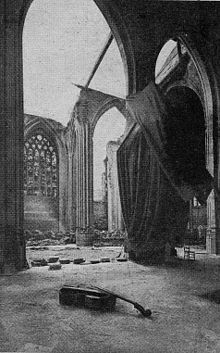

The forerunners of the aerial bombs were the balloon bombs . These were balloons that were supposed to carry explosives over an enemy fortress and drop them on them. This idea was first realized in 1849 by the Austrian siege army off Venice , but the success was little.
The advances in airship travel and explosives technology then prompted this idea to be taken up again at the end of the 19th century. The Gower system was developed in France, and General Russel Thayer made a dynamite balloon in the USA . The German engineer and aeronaut Georg Rodeck has been working with the aerobombs since 1882 and designed electric air propulsion torpedo columns and air propulsion torpedoes with a timer to trigger the explosion. At the torpedo columns, a passenger balloon led four torpedo balloons, each of which carried about 50 to 75 kilograms of nitrate in a metal box, over the fortress, and the explosive boxes could be triggered via the electrical line either simultaneously or one after the other. When they fell, the boxes burst and hurled about 100 dynamite cartridges in an arc in all directions.
At the Hague Peace Conference of 1899, the constructing states committed themselves for a period of five years (i.e. until July 28, 1904) to prohibit the dropping of explosives from balloons or similarly constructed aircraft. The treaty was renewed at the second conference by the Convention of October 18, 1907, but it was not signed by various states.
The idea of the actual aerial bomb was then conceived in 1910 by the British RP Hearne in Airships in Peace and War in order to be able to carry out punitive expeditions more cheaply. The concept of aerial warfare quickly gained popularity in military circles.
The first bombing in history took place on November 1, 1911 as part of the Italo-Turkish War . Giulio Gavotti dropped four bombs weighing just under one and a half kilograms over Libya by hand from an Etrich pigeon .
The Bulgarian pilot Simeon Petrow developed the first aerial bomb with tail fin and detonator in 1912 in the First Balkan War . This bomb, weighing around 6 kg, was used for the first time in an attack on the Turkish train station near Karaağaç . The plans for this bomb were later sold to Germany.
In 1912, France launched the first major bombardment in Morocco , choosing large targets such as villages. The following year, Spain conquered another part of Morocco with fragmentation bombs made in Germany.
In the First World War , bombers were used for the first time, in which the aerial bombs were no longer thrown out of the observation post, but were released from the fuselage or the lower wing.
The first aerial bombs of the war were very improvised and did not have good fall properties.
As "P. u. W. Bombe ”was the name of an aerial bomb developed in 1916 by the testing institute and shipyard (P. u. W.) of the aviation troop (later aircraft maintenance service) in Berlin-Johannisthal together with the Goerz company in Berlin-Friedenau was produced. In addition to a 12.5 kg thick-walled fragmentation bomb, the other models with 50, 100, 300 and 1000 kg were thin-walled bombs with a high proportion of explosives. The P&W models were the very first modern aircraft bombs. In contrast to the earlier pear-shaped carbonite bombs with a ring tail, the P&W bombs were teardrop-shaped and slim and at the stern there was a three-wing tail, the fins of which were folded and thereby set the bomb in rotation. The ballistic properties were incomparably better than those of the early Carbonit models. As far as is known, the 1000 kg model was only dropped once from a Zeppelin Staaken R VI over London, whereas the 50, 100 and 300 kg models were used on the G aircraft. The smallest model was often thrown by hand, while all other models were carried on bomb locks.
In 1919, the social democratic government used aerial bombs in the urban area of Berlin to suppress the Spartakus uprising , for example against the editorial building of the SPD newspaper “Vorwärts” and the Schultheiss brewery , in which hundreds of insurgents had holed up.
Even then, the main problem with bombs was the lack of accuracy. Winston Churchill was so shocked in 1920 after reading a report of a bombing of Baghdad in which the civilian population was also badly hit that he banned further reports of this kind. However, it was Churchill who had previously called for the bombing of Iraqi insurgents with poison gas. Often officers who saw the consequences of such attacks and described them as massacres, resigned from their posts in the colonies and preferred to return to England.
In the Rif War between Spain and Morocco on June 29, 1924, 600 bombs were dropped near Tétouan and the civilian population was badly hit.
During the Spanish Civil War , the German Wehrmacht used their weapons aid for Franco's troops to practice and perfect the bombing of entire cities. The small Basque town of Guernica was attacked on April 26, 1937 by the Condor Legion of the German Air Force and largely destroyed. The world public reacted with consternation, while German military circles were satisfied. Pablo Picasso dedicated his Guernica painting to this horror .
"Spain gave me the opportunity to try out my young air force [...] and the people to gain experience."
After a French attack on the Muslim quarter of Damascus ( Syria ), great discussions arose as to whether such attacks were justifiable under international law. The theory then emerged that humanity should be divided into civilized, barbarian and savage , and that only attacks on civilized peoples violated international law. This legitimized the attack on Syria and it was even claimed that France was acting on behalf of the League of Nations in Syria.
In contrast, the case of Ethiopia , which was independent and a member of the League of Nations and was attacked by Italy in 1935 , was different . During the Abyssinian War (1935–1936), the Italian air force carried out massive bombings, including mustard gas bombs. These attacks were seen as a violation of international law. However, the Italian annexation of Ethiopia was recognized by the League of Nations.
During the course of the Second World War, all warring parties carried out large-scale bombing of cities. The first major bomb attack of this kind was carried out by the German Air Force on Warsaw in September 1939 in order to weaken the resistance of the units that had fled into the city and to persuade the Polish government to surrender. During the Battle of Britain 1940–1941, London in particular was hit hard, with more than 30,000 people dying in the attacks known as The Blitz . The industrial city of Coventry also gained notoriety in November 1940, when it was heavily bombed by the Air Force during Operation Moonlight Sonata , killing 568 people. On April 8, 1941, Coventry was once again the target of an air force attack, with the number of casualties in Coventry rising to over 1,000. Due to the relatively high degree of destruction in the city (75% of the industrial facilities were destroyed, including the Rolls-Royce aircraft engine plant ), the attack was celebrated by German propaganda as an extraordinary success. Propaganda Minister Joseph Goebbels coined the expression " Coventrieren " for such a destructive attack from the air. The attacks on the “Street of Life”, a supply route across the frozen Lake Ladoga during the Leningrad blockade from September 8, 1941 to January 18, 1944, caused a particularly high number of victims. As a result of the attacks by the German air force, 16,470 civilians died from direct bombing, more than 100,000 Leningraders froze to death or starved to death, as food and coal stores were particularly targeted by the air raids.

In early 1942, units of the British Royal Air Force under the command of Air Force Marshal Arthur Harris ("Bomber Harris") initially carried the aerial warfare into the German Reich . The RAF Bomber Command and from 1943 also the United States Army Air Forces carried out massive bombings of major German cities, such as the attacks on Hamburg from July 24, 1943 to August 3, 1943 , known as Operation Gomorrah . As the majority of the bombs dropped on Hamburg consisted of incendiary bombs, massive fires broke out in the entire Hamburg area during and after Operation Gomorrah (see also: Firestorm ). More than 34,000 people died and over 125,000 were injured. Although the Second World War was nearing its end in Europe, bombs continued to be dropped on German cities in 1945. Partly to weaken the remaining units of the Wehrmacht , but also to deliberately demoralize the civilian population. Dresden was bombed from February 13-15, 1945 by the RAF at night and the USAAF during the day. Since there were many refugees from East Prussia and other major German cities in the city at the time of the air raids on Dresden , the number of victims was high. The initial estimates were 40,000 deaths and occasionally went into the six-figure range; today, a minimum of 22,700 and a maximum of 25,000 victims is considered likely. The German propaganda by Joseph Goebbels gave about ten times that number, they wanted to use the catastrophe to discredit the so-called anti-Hitler coalition internationally. The first post-war mayor of Dresden, Walter Weidauer, described the attacks as a necessary evil in 1946; during the course of the Cold War the GDR claimed that the attack only took place in order to leave only a burned East Germany to the advancing Red Army at the time .
In total, the Allies dropped 2.67 million tons of bombs in Europe during the Second World War.
However, the bombing did not reach its peak in Europe , but in Japan with the devastating fire bombing raids on Tokyo and other large cities, with hundreds of thousands of Japanese civilians being killed within a few months from the beginning of 1945. The dropping of the Little Boy atomic bomb on August 6, 1945 by the B-29 (Superfortress) bomber Enola Gay over the port city of Hiroshima ushered in a new era . Little Boy exploded 600 meters above the target, killing over 140,000 people instantly. Since Japan still did not surrender after the bombing, three days after the Hiroshima drop the B-29 Bockscar bomber was sent to Nagasaki to drop the Fat Man atomic bomb there . Due to poor visibility over the target area, the bomb missed its target by almost two kilometers, but more than 50,000 people died in the explosion. The figures for the late victims of these two atomic explosions vary considerably from 300,000 to 700,000 people.
US air strikes in the Korean War (1950–1953) and Vietnam War (1964–1975) (more ammunition was dropped there than in the entire Second World War) caused seven-figure civilian casualties and left widespread devastation.
The heaviest aerial bomb ever dropped is the British Grand Slam from World War II with a total mass of around 10 tons . The most powerful known non- nuclear aerial bomb in terms of explosive power is today the Russian “ father of all bombs ” .
literature
- Wolfgang Thamm: Fliegerbomben , Bernard & Graefe Verlag, Bonn 2003, ISBN 3-7637-6228-0
Web links
- Air bomb in Schwabing: pictures of the Munich fire brigade
- Air bomb in Schwabing: the morning after - damage balance
Individual evidence
- ↑ Archive link ( Memento from December 30, 2016 in the Internet Archive )
- ↑ Göttinger Tageblatt from June 1, 2010: Göttingen: Three dead in bomb explosion ( Memento from June 4, 2010 in the Internet Archive )
- ^ Deutsche Welle of June 1, 2010: World War Bomb kills three defusers
- ↑ Focus from January 3, 2014: Euskirchen: Excavator encounters explosive device
- ↑ Time online from January 6, 2014: Dud was a British air mine
- ↑ The city of Graz's bombing cadastre ( memento from August 30, 2016 in the Internet Archive ) City of Graz City Administration, no year, accessed on August 30, 2016.
- ↑ a b derStandard.at: Why did the bomb explode in Salzburg? . Article dated July 20, 2003, accessed September 21, 2017.
- ↑ Bomb alarm: Flieberbombe paralyzed Graz kleinezeitung.at, March 26, 2011, accessed on August 30, 2016.
- ↑ Air bomb is blown up in Linz orf.at, August 30, 2016, accessed on August 30, 2016. - Image of the explosive cloud.
- ↑ Detonation of a 250kg aerial bomb in Linz-Ebelsberg laumat.at, Matthias Lauber, August 30, 2016, accessed on August 30, 2016.
- ↑ Air bomb discovered in Vienna-Liesing: U6 blocked . Article dated September 21, 2017, accessed September 21, 2017.
- ^ Johann Werfring: K. uk balloon bombs on the city of Venice, ( Memento from July 19, 2016 in the Internet Archive ) in: Wiener Zeitung , March 18, 2010, supplement "Program Points" p. 7.
- ↑ Aërobomben, in: Brockhaus encyclopedia , publishing house FA Brockhaus , 14th Edition, 1894-1896, p 163rd
- ↑ 20 minutes from 13./14. May 2011: Description of the first bomb drop
- ^ Bulgarian Aviation in the Great War (English), accessed on April 5, 2018
- ↑ Jochen Gartz: From Greek fire to dynamite: A cultural history of explosives. ES Mittler & Sohn , Hamburg 2007, ISBN 978-3-8132-0867-2 .
